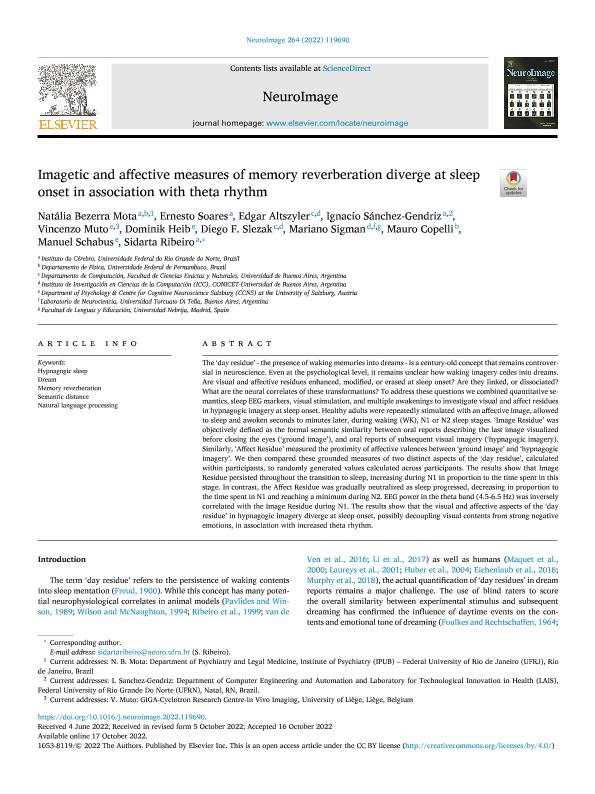Mostrar el registro sencillo del ítem
dc.contributor.author
Mota, Natália Bezerra
dc.contributor.author
Soares, Ernesto
dc.contributor.author
Altszyler Lemcovich, Edgar Jaim

dc.contributor.author
Sánchez Gendriz, Ignacio
dc.contributor.author
Muto, Vincenzo
dc.contributor.author
Heib, Dominik
dc.contributor.author
Fernandez Slezak, Diego

dc.contributor.author
Sigman, Mariano

dc.contributor.author
Copelli, Mauro
dc.contributor.author
Schabus, Manuel
dc.contributor.author
Ribeiro, Sidarta
dc.date.available
2023-11-10T15:27:18Z
dc.date.issued
2022-12
dc.identifier.citation
Mota, Natália Bezerra; Soares, Ernesto; Altszyler Lemcovich, Edgar Jaim; Sánchez Gendriz, Ignacio; Muto, Vincenzo; et al.; Imagetic and affective measures of memory reverberation diverge at sleep onset in association with theta rhythm; Academic Press; Journal Neuroimag; 264; 12-2022; 1-11
dc.identifier.issn
1053-8119
dc.identifier.uri
http://hdl.handle.net/11336/217780
dc.description.abstract
The ‘day residue’ - the presence of waking memories into dreams - is a century-old concept that remains controversial in neuroscience. Even at the psychological level, it remains unclear how waking imagery cedes into dreams. Are visual and affective residues enhanced, modified, or erased at sleep onset? Are they linked, or dissociated? What are the neural correlates of these transformations? To address these questions we combined quantitative semantics, sleep EEG markers, visual stimulation, and multiple awakenings to investigate visual and affect residues in hypnagogic imagery at sleep onset. Healthy adults were repeatedly stimulated with an affective image, allowed to sleep and awoken seconds to minutes later, during waking (WK), N1 or N2 sleep stages. ‘Image Residue’ was objectively defined as the formal semantic similarity between oral reports describing the last image visualized before closing the eyes (‘ground image’), and oral reports of subsequent visual imagery (‘hypnagogic imagery). Similarly, ‘Affect Residue’ measured the proximity of affective valences between ‘ground image’ and ‘hypnagogic imagery’. We then compared these grounded measures of two distinct aspects of the ‘day residue’, calculated within participants, to randomly generated values calculated across participants. The results show that Image Residue persisted throughout the transition to sleep, increasing during N1 in proportion to the time spent in this stage. In contrast, the Affect Residue was gradually neutralized as sleep progressed, decreasing in proportion to the time spent in N1 and reaching a minimum during N2. EEG power in the theta band (4.5-6.5 Hz) was inversely correlated with the Image Residue during N1. The results show that the visual and affective aspects of the ‘day residue’ in hypnagogic imagery diverge at sleep onset, possibly decoupling visual contents from strong negative emotions, in association with increased theta rhythm.
dc.format
application/pdf
dc.language.iso
eng
dc.publisher
Academic Press

dc.rights
info:eu-repo/semantics/openAccess
dc.rights.uri
https://creativecommons.org/licenses/by/2.5/ar/
dc.subject
DREAM
dc.subject
HYPNAGOGIC SLEEP
dc.subject
MEMORY REVERBERATION
dc.subject
NATURAL LANGUAGE PROCESSING
dc.subject
SEMANTIC DISTANCE
dc.subject.classification
Otras Ciencias Médicas

dc.subject.classification
Otras Ciencias Médicas

dc.subject.classification
CIENCIAS MÉDICAS Y DE LA SALUD

dc.title
Imagetic and affective measures of memory reverberation diverge at sleep onset in association with theta rhythm
dc.type
info:eu-repo/semantics/article
dc.type
info:ar-repo/semantics/artículo
dc.type
info:eu-repo/semantics/publishedVersion
dc.date.updated
2023-11-09T14:17:07Z
dc.journal.volume
264
dc.journal.pagination
1-11
dc.journal.pais
Estados Unidos

dc.description.fil
Fil: Mota, Natália Bezerra. Universidade Federal de Pernambuco; Brasil. Universidade Federal do Rio Grande do Norte; Brasil
dc.description.fil
Fil: Soares, Ernesto. Universidade Federal do Rio Grande do Norte; Brasil
dc.description.fil
Fil: Altszyler Lemcovich, Edgar Jaim. Consejo Nacional de Investigaciones Científicas y Técnicas. Oficina de Coordinación Administrativa Ciudad Universitaria. Instituto de Investigación en Ciencias de la Computación; Argentina
dc.description.fil
Fil: Sánchez Gendriz, Ignacio. Universidade Federal do Rio Grande do Norte; Brasil
dc.description.fil
Fil: Muto, Vincenzo. Universitat Salzburg; Austria
dc.description.fil
Fil: Heib, Dominik. Universitat Salzburg; Austria
dc.description.fil
Fil: Fernandez Slezak, Diego. Consejo Nacional de Investigaciones Científicas y Técnicas. Oficina de Coordinación Administrativa Ciudad Universitaria. Instituto de Investigación en Ciencias de la Computación; Argentina
dc.description.fil
Fil: Sigman, Mariano. Universidad Torcuato Di Tella; Argentina. Consejo Nacional de Investigaciones Científicas y Técnicas; Argentina
dc.description.fil
Fil: Copelli, Mauro. Universidade Federal de Pernambuco; Brasil
dc.description.fil
Fil: Schabus, Manuel. Universitat Salzburg; Austria
dc.description.fil
Fil: Ribeiro, Sidarta. Universidade Federal do Rio Grande do Norte; Brasil
dc.journal.title
Journal Neuroimag

dc.relation.alternativeid
info:eu-repo/semantics/altIdentifier/url/https://www.sciencedirect.com/science/article/pii/S1053811922008114
dc.relation.alternativeid
info:eu-repo/semantics/altIdentifier/doi/http://dx.doi.org/10.1016/j.neuroimage.2022.119690
Archivos asociados
